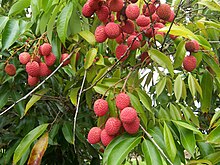Our website is made possible by displaying online advertisements to our visitors.
Please consider supporting us by disabling your ad blocker.
Lychee
| Lychee | |
|---|---|

| |
| Scientific classification | |
| Kingdom: | Plantae |
| Clade: | Tracheophytes |
| Clade: | Angiosperms |
| Clade: | Eudicots |
| Clade: | Rosids |
| Order: | Sapindales |
| Family: | Sapindaceae |
| Tribe: | Nephelieae |
| Genus: | Litchi Sonn. |
| Species: | L. chinensis
|
| Binomial name | |
| Litchi chinensis | |
| Synonyms[2] | |
| |
| Lychee | |||||||||||||||||||||||||||
|---|---|---|---|---|---|---|---|---|---|---|---|---|---|---|---|---|---|---|---|---|---|---|---|---|---|---|---|
| Chinese | 荔枝 | ||||||||||||||||||||||||||
| |||||||||||||||||||||||||||
Lychee[3] (US: /ˈliːtʃiː/ LEE-chee, UK: /ˈlaɪtʃiː/ LIE-chee; Litchi chinensis; Chinese: 荔枝; pinyin: lìzhī; Jyutping: lai6 zi1; Pe̍h-ōe-jī: nāi-chi) is a monotypic taxon and the sole member in the genus Litchi in the soapberry family, Sapindaceae.
There are three distinct subspecies of lychee. The most common is the Indochinese lychee found in South China, Malaysia, and northern Vietnam. The other two are the Philippine lychee (locally called alupag or matamata) found only in the Philippines and the Javanese lychee cultivated in Indonesia and Malaysia.[4][5] The tree has been introduced throughout Southeast Asia and South Asia.[5] Cultivation in China is documented from the 11th century.[4] China is the main producer of lychees, followed by India, Vietnam, other countries in Southeast Asia, other countries in South Asia, Madagascar, and South Africa. A tall evergreen tree, it bears small fleshy sweet fruits. The outside of the fruit is a pink-red, rough-textured soft shell.
Lychee seeds contain methylene cyclopropyl glycine which has caused hypoglycemia associated with outbreaks of encephalopathy in undernourished Indian and Vietnamese children who consumed lychee fruit.[6][7]
- ^ "Litchi chinensis". Germplasm Resources Information Network. Agricultural Research Service, United States Department of Agriculture. Retrieved 19 January 2010.
- ^ "Litchi chinensis (Thunb.) H.Deane". World Flora Online. World Flora Consortium. 2022. Retrieved 17 December 2022.
- ^ Also sometimes spelled litchi, liechee, liche, lizhi, li zhi, or lichee.
- ^ a b Morton J (1987). Lychee. In: Fruits of Warm Climates. West Lafayette, Indiana, USA: Center for New Crops and Plant Products, Purdue University, Department of Horticulture and Landscape Architecture. pp. 249–259. Retrieved 30 October 2013.
- ^ a b "Litchi chinensis Sonn. | Plants of the World Online | Kew Science".
- ^ Spencer PS, Palmer VS (2017). "The enigma of litchi toxicity: an emerging health concern in southern Asia". The Lancet. Online, 30 January 2017 (4): e383 – e384. doi:10.1016/S2214-109X(17)30046-3. PMID 28153516.
- ^ Aakash Shrivastava, Anil Kumar, Jerry D Thomas, et al. (2017). "Association of acute toxic encephalopathy with lychee consumption in an outbreak in Muzaffarpur, India, 2014: a case-control study". The Lancet. 30 January 2017 (online) (4): e458 – e466. doi:10.1016/S2214-109X(17)30035-9. PMID 28153514.
Previous Page Next Page


